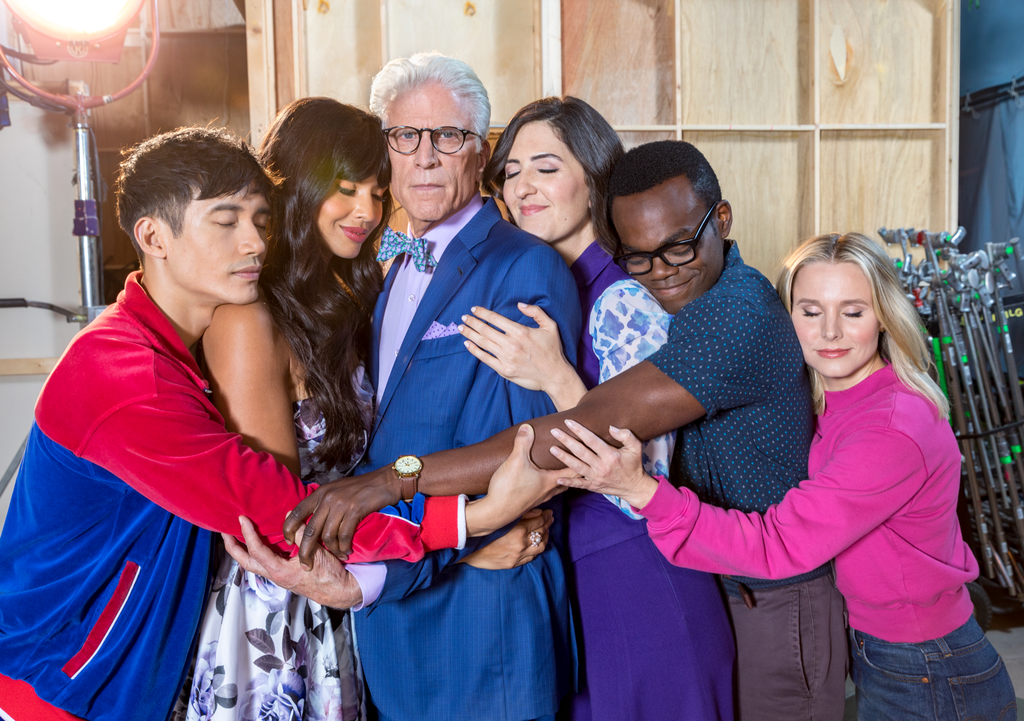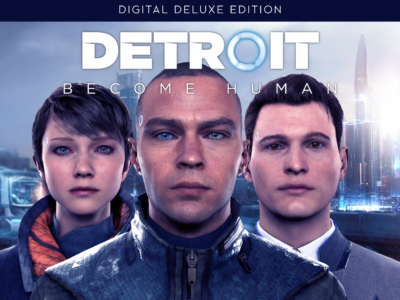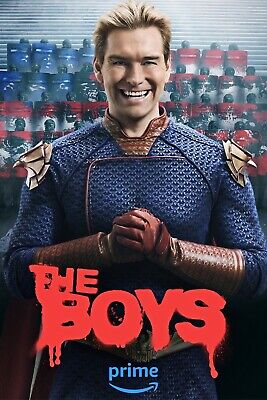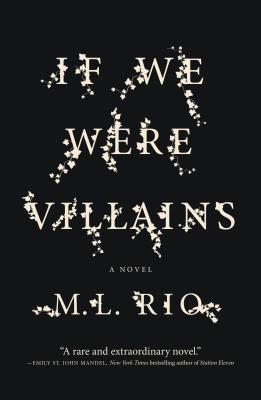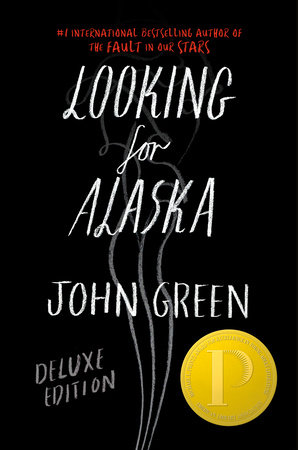About a year ago, during the spring semester of my freshman year here at UNH, I took a Bioethics class. About midway into the semester, our Professor played us a clip from a TV Show that I had heard of but have never seen before – The Good Place. He wanted to introduce the notorious Trolley Problem to us, but from the point-of-view of someone who had studied ethics all their life. The clip began with a man, who was an Ethics Professor, simulating the Trolley Problem in real time. He was given the choice to either pull the lever to divert the train, which would ultimately kill the life of one person, but save 5 others in the process. He was debating with himself for too long, and couldn’t make a decision, which ended in him killing the 5 people.
Although this clip was about 3 minutes long, I was deeply intrigued by this scene, wanting to know more about the show. I remember searching the show up later that day, and saw that it was on Netflix. I saw the trailer and read the synopsis, readily excited to indulge in a new TV show. I remember thinking to myself – how haven’t I been interested in it before as its a comedy show (my favorite genre) with such a unique plot. I began watching the first season that very same day.
Describe your Experiences
The first episode already had me inserting myself in this other world, putting myself in Eleanor’s shoes – who is the main character of the show – wondering if I would follow her idea of pretending to be someone else, or if I would follow my own personal morals and tell the truth. This is when suspended judgement came into light. We are just informed that our “time on Earth has ended“, and that we’re now in the afterlife. We are hearing and viewing the life of someone else rather than ours, while also being put into a new environment that was not designed for us. It leads to a major internal dilemma of, A, tell the truth, and reveal that we are not the right person; or B, continue to live in this other person’s afterlife journey, stripping the experience for them and those currently around us – most notably, Chidi (Eleanor’s ‘soulmate’).
Having immersed myself into this show, it simultaneously began to bring to light my inner self. I was examining my life, relearning my past experiences to see if I would qualify for ‘The Good Place’. I was reminded of the bad and good things I’ve done. But, what I most remember feeling was paranoia. If I was Eleanor, I would’ve been so overwhelmed with trying to hide my true identity, while also helping Michael (the architect who designed the afterlife neighborhood they live in) find out what’s causing all this chaos and destruction that going on around us. With this feeling, I just knew that I would’ve confessed and saved everyone the trouble of more disarray and overall madness in a place that is designed to be a blissful paradise. I would classify this feeling as moral omniscience. There is a clear sense of what the right thing to do is, but what arises from it is if one would choose to do the right thing (in this case, voluntarily go to hell). I think this main conflict in the storyline of season one explains why this show made such an impact on me. It allowed me to reflect on my morals, and overall self, while also instilling an idea of some obscured qualities of mine.
Features of the Story
What made me connect to the story was how it unironically encourage me to constantly strive to become a better version of myself. It also opened me up to a few new perspectives on life that were unknown to me.
From What I Remember
From what I can remember, throughout the first few episodes of the first season, I remembering feeling somewhat conflicted by Eleanor’s character. I was confused about my feelings about her; firstly, she was not really putting in any effort into becoming a better person, which would, in turn, increase her chances of blending in with those around her. To add on, the flashbacks we got to see of who she was on Earth was worsening her case as she was self-centered and inconsiderate at many times. But, on the other hand, the show begins to gradually progress Eleanor’s character into someone who is trying to make a better change for themselves. She then starts to change for Chidi as well, showing that she has the capabilities of recognizing her faults and the ability to change for not only herself, but for others around her. She is also a relatable character; I found myself connecting with her at many moments throughout the show. I thought these noticeable changes were enough to make me feel empathy for her, wanting to continue the show to see how she would ultimately end up.
What Happened
After rewatching the first few episodes, there was some things I missed. Firstly, Tahini. She is Eleanor’s next door neighbor and the two become friends as Tahini confesses her struggles of connecting with her soulmate, Jianyu – a Buddhist Monk who swore to take a vow of silence since he was a young boy (in reality, he is in the same situation as Eleanor, and his real name is Jason). I forgot how unflattering her character was despite her portraying an admirable, pleasant person. She’s condescending, and continued to flaunt her accomplishments at any moment she got. I felt that her character was not adding much value to the plot, making me lose that initial connection I made with the show, mainly through Eleanor and Chidi.
However, when I finished the season, I realized how the relationship she shared with Eleanor allowed for Tahini to grow and acknowledge her faults. Eleanor is not afraid to be the one to point out when Tahini is acting fake and phony. She sees that Tahini is looking for that external validation and calls her out on it. Tahini finally notices this herself, and starts to hold herself accountable, changing for the better.
Next, Michael, the architect who designed the afterlife neighborhood they are all living in. He also acts as someone to go to when the residents need guidance or help adjusting to this new change. I forgot how convincing he was throughout the entire first season – this will make sense in just a few moments.
And finally, I honestly forgot how impactful that plot twist was at the end. (Spoiler ahead)! I remember watching the scene for the first time, noticing how things were getting so chaotic and noting that no paradise afterlife should consist of this. And that’s when the camera panned to Eleanor’s face, with her connecting everything together, delivering the iconic line, “THIS is the Bad Place”. I honestly thought that this was such a good twist that made the story more meaningful. I thought this one line made the entire season and the one that came after it. I remember how jaw dropping this was for me the first time, as I didn’t really see the connections at first until that last episode. Watching it a second time around, I thought the connection was more beautiful as it was such a relief on me as the viewer but also for the characters because now they have the answer for why their ‘paradise’ was torturous from day one.
Narrative Technologies Used In Creating These Features
Because I had immersed myself in the show from the first episode onwards, I felt more of an obligation to try and find explanations for everything wrong that was occurring throughout the first season. It was easy to blame everything on Eleanor since we’re told from the beginning that she is not supposed to be there. But I like how the creator of the show was using Logic at the end of season one to explain Eleanor’s claim of how them, the humans (Eleanor, Chidi, Tahini, & Jason), are all in the Bad Place. Eleanor mentions, “It’s actually a filthy dumpster full of our worst anxieties”, as Chidi tries to rationalize the revelation that just unfolded before them. She continues to list examples of how each of them tortured one another.
To continue, I really enjoyed how the first few episodes of season two is essentially a condensed version of season one but with the perspective of Michael as his true form, a demon, as well as the all the other ‘residents’- who are also demons that were hired by Michael to act like residents but are to contribute to the humans torture. I also loved the use of flashbacks to give us a second look on things, just from another perspective, as I thought it added more depth to the plot.
With Michael’s true character being revealed, I can now see him as a reality shifter. Since his first failed attempt, and then second, he’s constantly making new ones to try and make the humans torture one another for as long as possible. With each attempt, the humans memory are wiped. He changes the storyline, designs the neighborhood differently, and even changed the humans soulmates as ways to prolong their torture (there is thankfully a video on youtube that shows all the reboots, and with each one, you can see Michael begin to lose hope). But it seems that with every new attempt (there had been over 800), the humans are continuously figuring out that they are actually in the Bad Place, prompting Michael to restart the experiment once more. To add on, we also see the opportunity to observe take place through Michael during these first few episodes of the second season. As Michael is getting fail after fail with his experiment, he begins to lose himself. He doubts himself as an Architect and begins to lose all hope for his experiment. And with the consistent check-ins from his boss (who believes Michael is only on attempt number two), he feels that he is only achieving closer to retirement (a punishment to demons that consists of never-ending torture for eternity). Seeing this side of Michael, surprisingly made me feel bad for him. Just seeing him at nearly rock bottom was hard to see. Especially when Jason, who’s character is known for not being the smartest, figured out that they were in the Bad Place, during one of the attempts. Michael finishes this attempt with, “This is a real low point. Yeah, this one hurts.” I just thought this was such a funny way to convey Michael’s consistent failure.
As I’m continuing to revisit the show, I remembered how Michael is teaming up with the humans. He realized that his attempts are going to be a constant failure, and to add on, the other demons are getting tired of keeping up with the act. However, once he is faced with blackmail by a demon named Vicky, who wants to run the next attempt and do things her way, he has no other choice but to agree to her terms. With this new dilemma, the humans and Michael have agreed to team up and play along to Vicky’s version with a new attempt. But, with the agreement that Michael finds a way to bring them to the real Good Place. This deal has somewhat of an enigma to it. Trying to get four people who’s life on Earth was deemed ‘bad’ enough to get them into the Bad Place, along with a literal demon, seems like it’s going to be an impossible task to earn themselves a spot in the Good place.
As we advance into the later seasons of three and four, we see this plan actually start to become possible. With this, we also see Michael want to actually become a good person, and we do see major character growth from him. I thought a major example was Michael bringing a gift to the Door Man (a being from the afterlife that holds the only key to Earth). We see Michael do a kind gesture to someone outside of the humans and Janet (a walking database who contains all the knowledge of the universe).
In a lucky twist, the humans + Michael actually get into the Good Place. Upon their arrival however, the system was very flawed. It’s revealed that it was near impossible to get into the Good Place, later explaining why they haven’t received anyone in centuries.
To combat this, the five of them, and Janet, try and fix the system to where it’s more of a fair chance for someone to get in. I remember them figuring this all out by creating a new system. Then with them all in the Good Place, we see death start to take rise as a subject. The remaining two episodes consisted of the characters starting to contemplate if they can live eternally in paradise. I thought this shift in focus was something that was looming over with the whole creation of the show. As I don’t know for sure, I interpreted the show as a journey of self discovery that will have you contemplating about certain aspects of who you are, how you perceive the world, and how the choices you make shapes your identity. With permeant death being an option this time (assuming we’re in the Good Place), you get to also ponder if you would want to live for an eternity. How do you determine if you’re ready to leave eternal paradise? It was constant questions such as this one that I was asking myself for the entirety of the show.
And I believe that because I was immersing myself into this story due to that immediate connection from the first episode, I began to: ask these questions; have many internal dilemma’s with myself; show empathy and express emotions for Eleanor, Chidi, Tahini, Jason, and even Michael; and figure things out about myself that were obscure to me. After concluding all these thoughts together, I am now realizing that this show allowed me to convey self-scrutiny. As I was watching the show, I was inadvertently examining different parts of myself as were the characters. It allowed me to hone in on specific aspects of life and dissect it, recognizing more about myself in the process. I would have never thought this show would had impacted me the way it did; and to think it all started with a 3 minute clip from a Bioethics class.
Works Cited
Comedy Bites. (2019a, March 22). Welcome to the Good Place – Everything is fine | The Good Place | Comedy bites [Video]. YouTube. https://www.youtube.com/watch?v=QcCHLfVdhXg
The Good Place. (2016a, September 20). The Good Place – someone royally forked up (Episode highlight) [Video]. YouTube. https://www.youtube.com/watch?v=NbWhYpjQnsc
Comedy Bites. (2019b, March 27). Something’s not right in the Good Place | The Good Place | Comedy bites [Video]. YouTube. https://www.youtube.com/watch?v=GKGc-ozTD7E
The Good Place. (2016b, September 20). The good place – she’s too selfish to be good (Episode highlight) [Video]. YouTube. https://www.youtube.com/watch?v=kuIhP2gj9FM
James. (2017, September 16). The Good Place season finale – Eleanor realizes the truth, Michael responds [Video]. YouTube. https://www.youtube.com/watch?v=SVG1YGdoCWo
The Good Place. (2024, October 22). Eleanor keeps figuring it out (and the one time Jason did) | The Good Place [Video]. YouTube. https://www.youtube.com/watch?v=PxiDoO84zjg
The Good Place. (2025, January 3). Best of Michael from Season 1 | The Good Place [Video]. YouTube. https://www.youtube.com/watch?v=rzs1X0u249I
NBC. (2020, April 9). Every reboot ever – the good place [Video]. YouTube. https://www.youtube.com/watch?v=brZtP21eLrs
The Good Place. (2016c, October 27). The Good Place – Retirement: An Animated Explanation (Digital Exclusive) [Video]. YouTube. https://www.youtube.com/watch?v=QP1DqABvvN8
Brian George. (2018, October 2). micheal gives the doorman a gift [Video]. YouTube. https://www.youtube.com/watch?v=uiW7l8q6TVg
The Good Place. (2019, January 18). Michael knows why the point system is broken – The Good Place (Episode highlight) [Video]. YouTube. https://www.youtube.com/watch?v=R8m_5HDZF7w
Experiences Glossary. (n.d.). Story & the Brain. Retrieved February 5, 2025, from https://unewhavendh.org/story-and-the-brain/experiences-glossary/
Technologies by Element of Narrative. (n.d.). Story & the Brain. Retrieved February 5, 2025, from https://unewhavendh.org/story-and-the-brain/technologies-by-element-of-narrative/
Featured Image
The cast of ‘‘The Good Place,’’ from left: Manny Jacinto, Jameela Jamil, Ted Danson, D’Arcy Carden, William Jackson Harper and Kristen Bell. Jeff Minton for The New York Times
